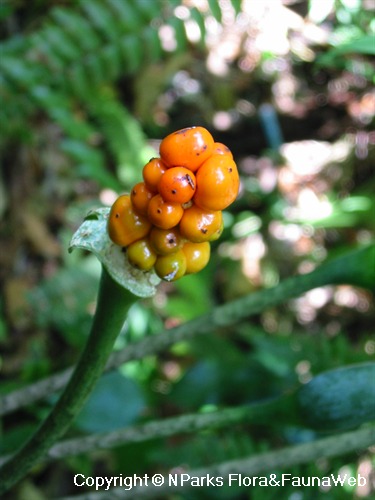
Back
Alocasia longiloba Miq.
| Family Name: | Araceae |
| Synonyms: | Alocasia denudata Engl., Alocasia lowii Hook. f., Alocasia singaporensis Linden, Alocasia veitchii (Lindl.) Schott, Caladium veitchii Lindl. |
| Common Name: | Keladi Rimau, Keladi Ular, Birah Kijang, Birah Hitam |
Alocasia longiloba is herbaceous plant that grows to 1.5 m tall. The leaves are large, arrow-shaped held on a mottled brown stalk. The flowers are held on a spadix enclosed in a green to white coloured spathe. This native herb is a good substitute for the exotic Alocasia macrorrhizos which also produces attractive large leaves suitable for partial to full shade sites including indoors.
Name
Classifications and Characteristics
| Plant Division | Angiosperms (Flowering Seed Plants) (Monocotyledon) |
|---|---|
| Plant Growth Form | Herbaceous Plant |
| Lifespan (in Singapore) | Perennial |
| Mode of Nutrition | Autotrophic |
| Maximum Height | 150 cm |
Biogeography
| Native Distribution | South Yunnan, Guangdong to West and Central Malesia |
|---|---|
| Native Habitat | Terrestrial (Primary Rainforest, Inland Cliff, Secondary Rainforest, Freshwater Swamp Forest, Riverine) |
| Preferred Climate Zone | Tropical |
| Local Conservation Status | Native to Singapore (Least Concern (LC)) |
Description and Ethnobotany
| Growth Form | It is a herb, up to 150 cm tall with a thickened lower stem (corm) up to 60 cm long. |
|---|---|
| Foliage | Its alternate, stalked leaves have leaf blades that are arrow head-shaped, dark green above, light green or purple on the underside, and 25-85 by 7-40 cm, with or without whitish veins. Its chocolate brown leaf stalk is usually mottled. |
| Flowers | Its flowers grow in a 6-13 cm long shoot enclosed by a greenish to white colour modified leaf (spathe) that is 9-10 cm long. |
| Fruit | Its fruits are round, orange, 4-7 mm long, and contain one large seed. |
| Habitat | It grows in swamp forests, bamboo thickets, cliffs, limestone, in regrowth, on exposed cliffs and ravines, and river-banks, up to 2,000 m altitude. |
| Associated Fauna | The flowers are pollinated by flies. The fruits are probably eaten by small mammals and birds. |
| Cultivation | It can be propagated by seed, or division of the buds off the corm. |
| Etymology | Latin, Alocasia, distinct from Colocasia. Latin, longiloba, long lobes, referring to the long lobes of the arrow-shaped leaves. |
| Ethnobotanical Uses | Others: It is grown as an ornamental plant. |
Landscaping Features
| Landscaping | It is a good native substitute for Alocasia macrorrhizos, an exotic species that is often cultivated in Singapore. The large, arrow-shaped leaves make this an attractive ornamental plant for backdrops or borders in partial shade to shaded sites. |
|---|---|
| Desirable Plant Features | Ornamental Foliage, Ornamental Fruits |
| Landscape Uses | Interiorscape/ Indoor Plant, General, Parks & Gardens, Small Gardens |
Fauna, Pollination and Dispersal
| Pollination Method(s) | Biotic (Fauna) |
|---|---|
| Seed or Spore Dispersal | Biotic (Fauna) |
Plant Care and Propagation
| Light Preference | Semi-Shade, Full Shade |
|---|---|
| Water Preference | Lots of Water, Moderate Water |
| Plant Growth Rate | Fast |
| Rootzone Tolerance | Moist Soils, Well-Drained Soils, Fertile Loamy Soils, Easy to Grow |
| Propagation Method | Seed, Division |
Foliar
| Foliage Retention | Evergreen |
|---|---|
| Mature Foliage Colour(s) | Green |
| Mature Foliage Texture(s) | Leathery |
| Foliar Type | Simple / Unifoliate |
| Foliar Arrangement Along Stem | Rosulate / Rosette |
| Foliar Attachment to Stem | Petiolate |
| Foliar Shape(s) | Non-Palm Foliage (Sagittate) |
| Foliar Venation | Pinnate / Net |
| Foliar Margin | Entire |
| Foliar Apex - Tip | Acute |
| Foliar Base | Sagittate |
| Leaf Area Index (LAI) for Green Plot Ratio | 3.5 (Shrub & Groundcover - Monocot) |
Non - Foliar and Storage
| Stem Type & Modification | Herbaceous |
|---|---|
| Root Type | Underground (Fibrous Root) |
| Specialised Storage Organ(s) |
Floral (Angiosperm)
| Flower & Plant Sexuality | Unisexual Flowers , Monoecious |
| Flower Colour(s) | Cream / Off-White, White |
|---|
| Flower Grouping | Cluster / Inflorescence |
| Flower Location | Terminal |
| Inflorescence Type | Spathe & Spadix |
| Flowering Habit | Polycarpic |
Fruit, Seed and Spore
| Mature Fruit Colour(s) | Orange |
|---|---|
| Mature Fruit Texture(s) | Glossy / Shiny |
| Fruit Classification | Simple Fruit |
| Fruit Type |
References
| References | Tan, P.Y., R.T. Corlett and H.T.W. Tan (Editors). 2010. A Field Guide to the Native Garden @ HortPark: an Urban Oasis of the Native Flora and Fauna of Singapore. Singapore: Centre for Urban Greenery and Ecology (National Parks Board) and National University of Singapore. 124pp |
|---|
Image Repository
Others
| Master ID | 337 |
|---|---|
| Species ID | 1633 |
| Flora Disclaimer | The information in this website has been compiled from reliable sources, such as reference works on medicinal plants. It is not a substitute for medical advice or treatment and NParks does not purport to provide any medical advice. Readers should always consult his/her physician before using or consuming a plant for medicinal purposes. |

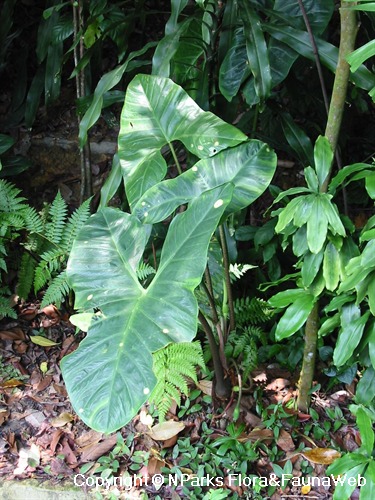
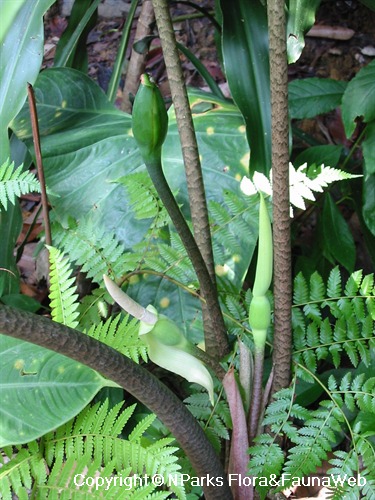
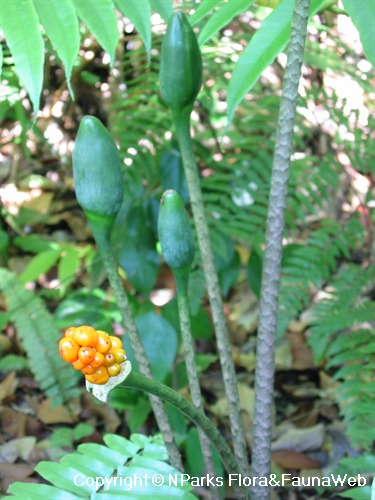

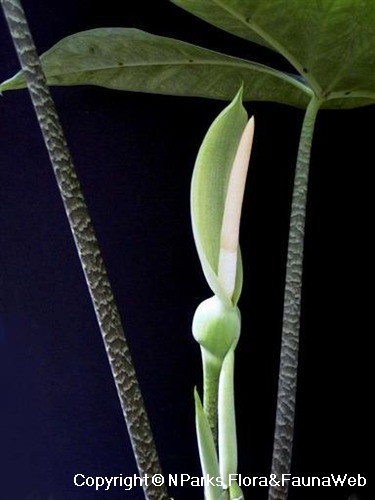
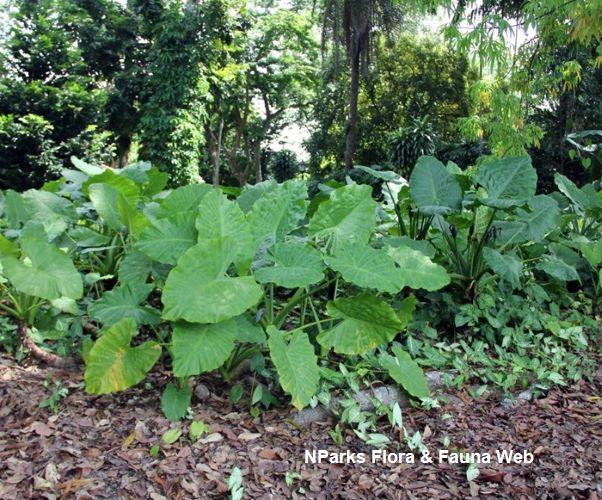


.jpg)